power steering Lancia Ypsilon 2003 Owner handbook (in English)
[x] Cancel search | Manufacturer: LANCIA, Model Year: 2003, Model line: Ypsilon, Model: Lancia Ypsilon 2003Pages: 191, PDF Size: 2.45 MB
Page 11 of 191
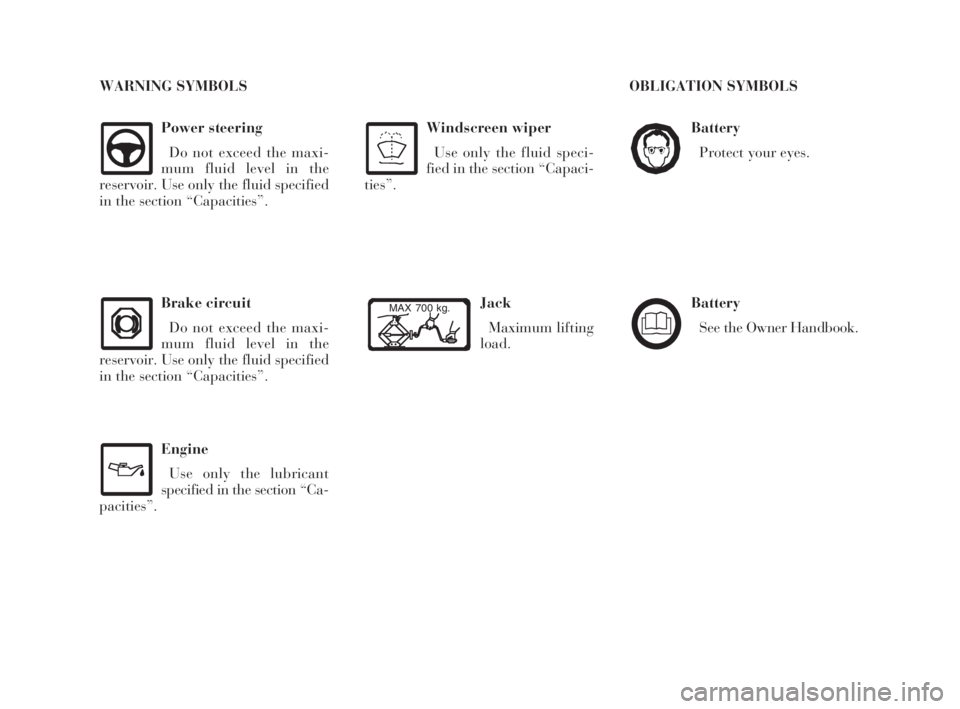
G
Battery
Protect your eyes.
Battery
See the Owner Handbook.
Power steering
Do not exceed the maxi-
mum fluid level in the
reservoir. Use only the fluid specified
in the section “Capacities”.
Brake circuit
Do not exceed the maxi-
mum fluid level in the
reservoir. Use only the fluid specified
in the section “Capacities”.
Windscreen wiper
Use only the fluid speci-
fied in the section “Capaci-
ties”.
Jack
Maximum lifting
load.MAX 700 kg.
WARNING SYMBOLS OBLIGATION SYMBOLS
Engine
Use only the lubricant
specified in the section “Ca-
pacities”.
4C001-067 ING 11-03-2008 11:57 Pagina 8
Page 22 of 191
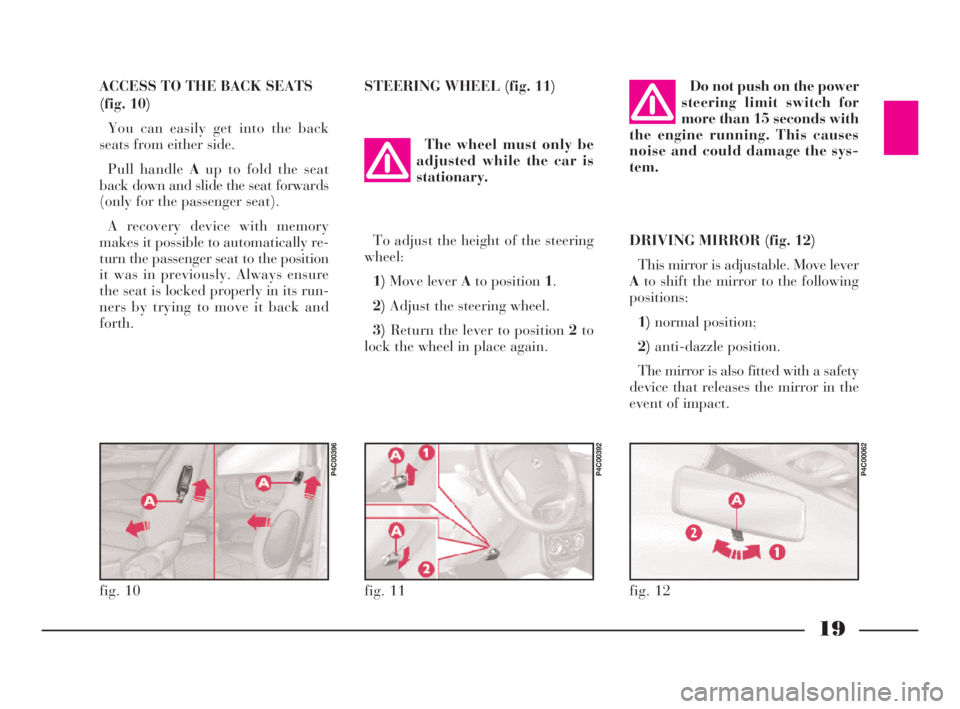
19
G
ACCESS TO THE BACK SEATS
(fig. 10)
You can easily get into the back
seats from either side.
Pull handle Aup to fold the seat
back down and slide the seat forwards
(only for the passenger seat).
A recovery device with memory
makes it possible to automatically re-
turn the passenger seat to the position
it was in previously. Always ensure
the seat is locked properly in its run-
ners by trying to move it back and
forth.STEERING WHEEL (fig. 11)
DRIVING MIRROR (fig. 12)
This mirror is adjustable. Move lever
Ato shift the mirror to the following
positions:
1)normal position;
2)anti-dazzle position.
The mirror is also fitted with a safety
device that releases the mirror in the
event of impact. The wheel must only be
adjusted while the car is
stationary.Do not push on the power
steering limit switch for
more than 15 seconds with
the engine running. This causes
noise and could damage the sys-
tem.
fig. 11
P4C00392
fig. 12
P4C00062
To adjust the height of the steering
wheel:
1)Move lever Ato position 1.
2)Adjust the steering wheel.
3)Return the lever to position 2to
lock the wheel in place again.
fig. 10
P4C00396
4C001-067 ING 11-03-2008 11:57 Pagina 19
Page 73 of 191

70
G
HOW TO WARM UP
THE ENGINE AFTER
IT HAS JUST STARTED
– Begin to move forward slowly let-
ting the engine turn over at medium
revs. Do not accelerate abruptly.
– Do not push the engine to its limit
for the first few kilometres. You are
recommended to wait until the water
temperature has reached 50°C to
60°C (pointer moves slightly from its
initial position).
EMERGENCY STARTING
If the Lancia CODE system fails to
recognise the code transmitted by the
ignition key (warning lamp ¢on in-
strument panel lit with a fixed light),
you can start the engine by following
the emergency procedure using the
code written on the CODE card.
See the section “In an emergency”.STOPPING THE ENGINE
Turn the ignition key to STOPwhile
the engine is idling.
Remember that as long as
the engine is not running,
the brake booster and
power steering do not work. You
therefore have to use considerably
more effort on both the brake
pedal and the steering wheel.
Bump starting by push-
ing, towing or rolling
downhill must be avoided
at all costs. This way of starting
could cause a rush of fuel into the
catalytic exhaust pipe and damage
it beyond repair.
BUMP STARTING
A quick burst on the ac-
celerator before turning off
the engine serves ab-
solutely no practical purpose, and
wastes fuel.
IMPORTANTAfter a taxing drive it
is better to allow the engine to “catch
its breath” before turning it off by let-
ting it idle to allow the temperature in
the engine compartment to fall.
4C068-089 ING 11-03-2008 11:59 Pagina 70
Page 80 of 191
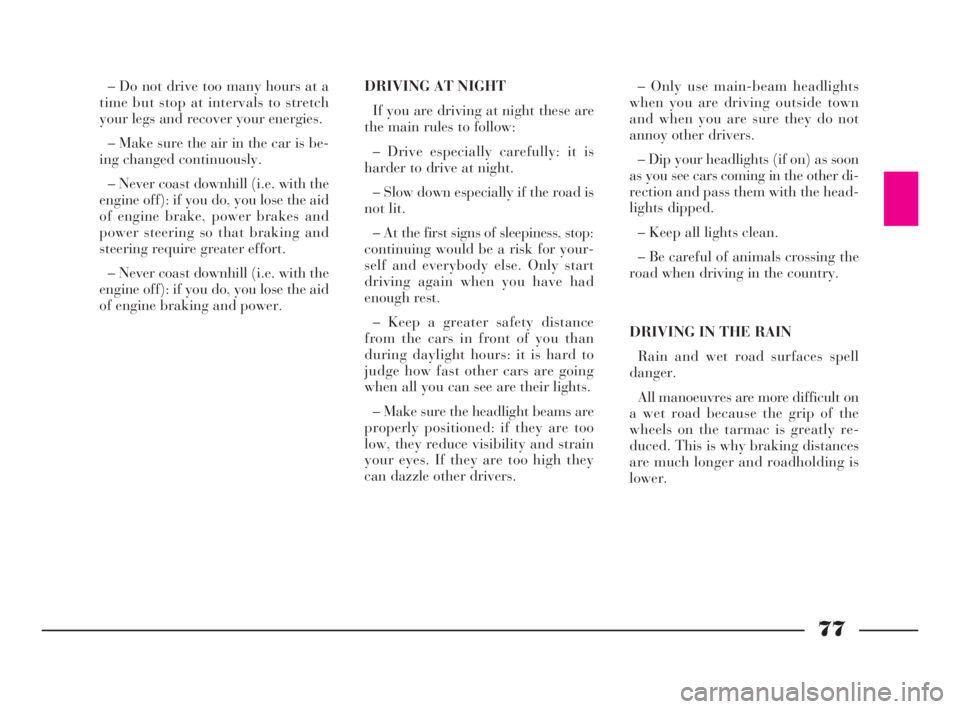
77
G
– Only use main-beam headlights
when you are driving outside town
and when you are sure they do not
annoy other drivers.
– Dip your headlights (if on) as soon
as you see cars coming in the other di-
rection and pass them with the head-
lights dipped.
– Keep all lights clean.
– Be careful of animals crossing the
road when driving in the country.
DRIVING IN THE RAIN
Rain and wet road surfaces spell
danger.
All manoeuvres are more difficult on
a wet road because the grip of the
wheels on the tarmac is greatly re-
duced. This is why braking distances
are much longer and roadholding is
lower. DRIVING AT NIGHT
If you are driving at night these are
the main rules to follow:
– Drive especially carefully: it is
harder to drive at night.
– Slow down especially if the road is
not lit.
– At the first signs of sleepiness, stop:
continuing would be a risk for your-
self and everybody else. Only start
driving again when you have had
enough rest.
– Keep a greater safety distance
from the cars in front of you than
during daylight hours: it is hard to
judge how fast other cars are going
when all you can see are their lights.
– Make sure the headlight beams are
properly positioned: if they are too
low, they reduce visibility and strain
your eyes. If they are too high they
can dazzle other drivers. – Do not drive too many hours at a
time but stop at intervals to stretch
your legs and recover your energies.
– Make sure the air in the car is be-
ing changed continuously.
– Never coast downhill (i.e. with the
engine off): if you do, you lose the aid
of engine brake, power brakes and
power steering so that braking and
steering require greater effort.
– Never coast downhill (i.e. with the
engine off): if you do, you lose the aid
of engine braking and power.
4C068-089 ING 11-03-2008 11:59 Pagina 77
Page 91 of 191
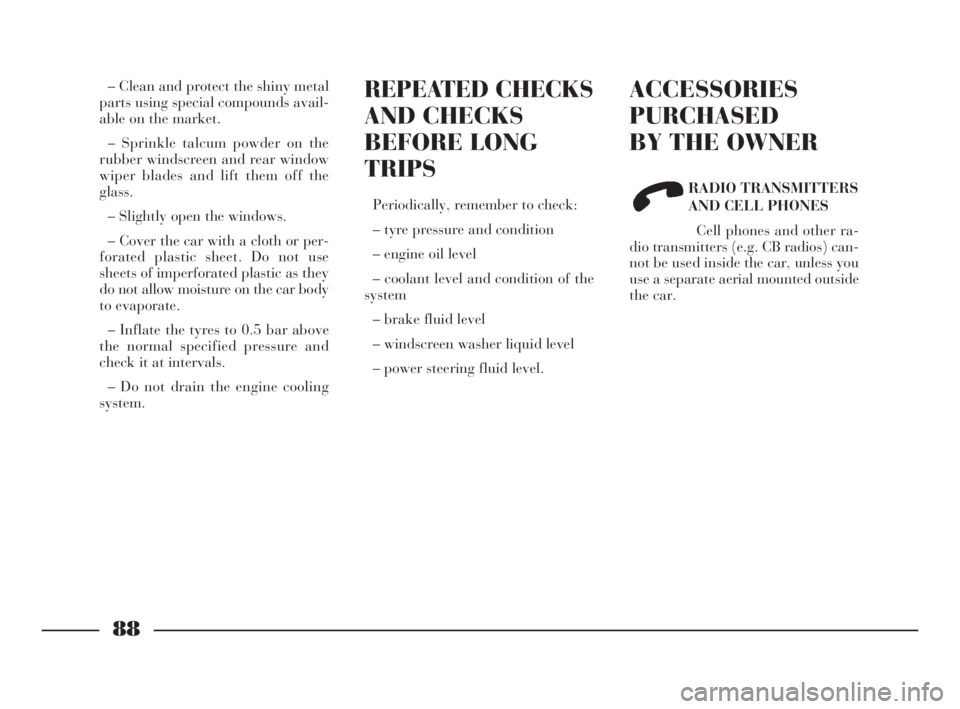
88
G
REPEATED CHECKS
AND CHECKS
BEFORE LONG
TRIPS
Periodically, remember to check:
– tyre pressure and condition
– engine oil level
– coolant level and condition of the
system
– brake fluid level
– windscreen washer liquid level
– power steering fluid level.
ACCESSORIES
PURCHASED
BY THE OWNER
RADIO TRANSMITTERS
AND CELL PHONES
Cell phones and other ra-
dio transmitters (e.g. CB radios) can-
not be used inside the car, unless you
use a separate aerial mounted outside
the car.
– Clean and protect the shiny metal
parts using special compounds avail-
able on the market.
– Sprinkle talcum powder on the
rubber windscreen and rear window
wiper blades and lift them off the
glass.
– Slightly open the windows.
– Cover the car with a cloth or per-
forated plastic sheet. Do not use
sheets of imperforated plastic as they
do not allow moisture on the car body
to evaporate.
– Inflate the tyres to 0.5 bar above
the normal specified pressure and
check it at intervals.
– Do not drain the engine cooling
system.
4C068-089 ING 11-03-2008 11:59 Pagina 88
Page 97 of 191

94
G
into the catalytic exhaust
pipe and damage it beyond
repair.
BUMP
STARTING
Bump starting by pushing, towing
or rolling downhill must be
avoided at all costs. This way of
starting could cause a rush of fuelRemember that as long as
the engine is not running,
the brake booster and
power steering do not work. You
therefore have to use considerably
more effort on both the brake
pedal and the steering wheel.
IF A TYRE
IS
PUNCTURED
GENERAL INDICATIONS
The following precautions must be
observed when changing a wheel and
using the jack and the space-saver
spare wheel.
4C090-119 ING 11-03-2008 12:00 Pagina 94
Page 120 of 191

117
fG
While the car is being
towed with the engine off,
remember that the brake
pedal and steering will require
more effort as you no longer have
the benefit of the brake booster
and power steering. Do not use
flexible cables to tow. Avoid jerk-
ing. Whilst towing, ensure that the
coupling to the car does not dam-
age the surrounding components.Do not extract the igni-
tion key during towing;
leave it at MAR, to prevent
the steering lock engaging and,
provided the electrical system is
not damaged, keep the brake lights
and direction indicators working.
When the ignition key is re-
moved, the steering lock will cut in
thus preventing the steering wheel
from being turned.IF AN ACCIDENT
OCCURS
– It is important to keep calm.
– If you are not directly involved,
stop at least ten metres away from the
accident.
– If you are on a motorway do not
obstruct the emergency lane with your
car.
– Turn off the engine and turn on
the hazard lights.
– At night, illuminate the scene of
the accident with your headlights.
– Act carefully, you must not risk
being run over.
– Mark the accident by putting the
red triangle at the regulatory distance
from the car where it can be clearly
seen.
– If the doors are jammed, do not try
to leave the car by breaking the glass
of the windscreen as the glass is strat-
ified. Side windows and the rear win-
dow can be broken more easily.
4C090-119 ING 13-03-2008 12:51 Pagina 117
Page 127 of 191
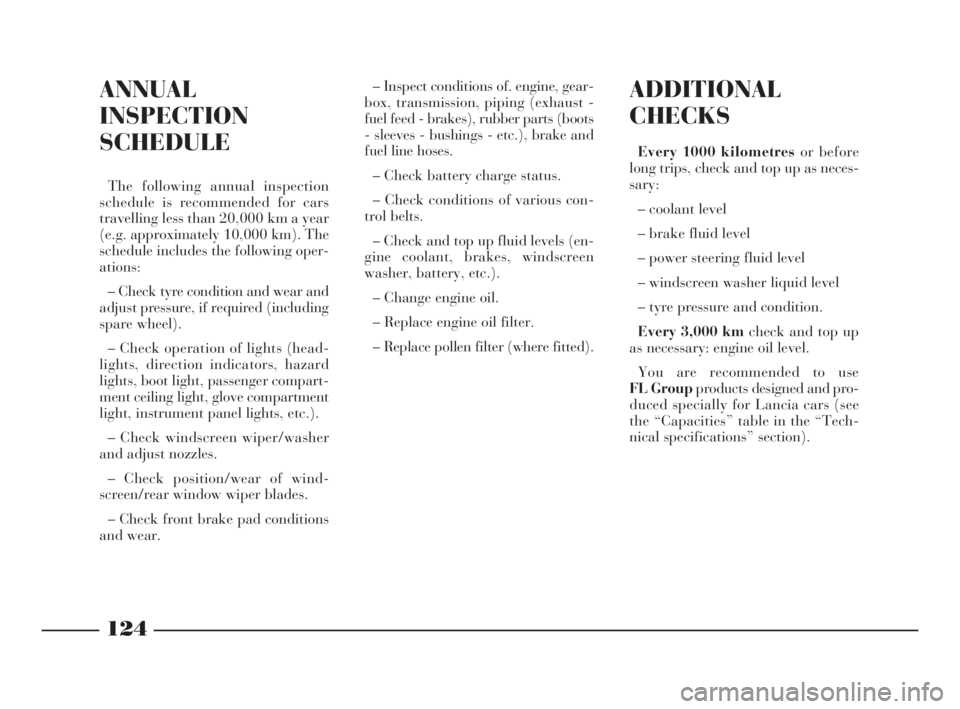
124
G
ADDITIONAL
CHECKS
Every 1000 kilometres or before
long trips, check and top up as neces-
sary:
– coolant level
– brake fluid level
– power steering fluid level
– windscreen washer liquid level
– tyre pressure and condition.
Every 3,000 kmcheck and top up
as necessary: engine oil level.
You are recommended to use
FL Groupproducts designed and pro-
duced specially for Lancia cars (see
the “Capacities” table in the “Tech-
nical specifications” section).
ANNUAL
INSPECTION
SCHEDULE
The following annual inspection
schedule is recommended for cars
travelling less than 20,000 km a year
(e.g. approximately 10,000 km). The
schedule includes the following oper-
ations:
– Check tyre condition and wear and
adjust pressure, if required (including
spare wheel).
– Check operation of lights (head-
lights, direction indicators, hazard
lights, boot light, passenger compart-
ment ceiling light, glove compartment
light, instrument panel lights, etc.).
– Check windscreen wiper/washer
and adjust nozzles.
– Check position/wear of wind-
screen/rear window wiper blades.
– Check front brake pad conditions
and wear.– Inspect conditions of. engine, gear-
box, transmission, piping (exhaust -
fuel feed - brakes), rubber parts (boots
- sleeves - bushings - etc.), brake and
fuel line hoses.
– Check battery charge status.
– Check conditions of various con-
trol belts.
– Check and top up fluid levels (en-
gine coolant, brakes, windscreen
washer, battery, etc.).
– Change engine oil.
– Replace engine oil filter.
– Replace pollen filter (where fitted).
4C120-143 ING 11-03-2008 12:01 Pagina 124
Page 130 of 191

127
G
CHECKING
FLUID LEVELS
fig. 1 - 1.2 versions
P4C00385
1.Engine oil - 2.Battery - 3.Brake
fluid - 4.Windscreen washer liquid -
5.Engine coolant - 6.Power-assisted
steering fluid.
1.Engine oil - 2.Battery - 3.Brake
fluid - 4.Windscreen washer liquid -
5.Engine coolant - 6.Power-assisted
steering fluid.
fig. 2 - 1.2 16Vversions
P4C00386
4C120-143 ING 11-03-2008 12:01 Pagina 127
Page 133 of 191
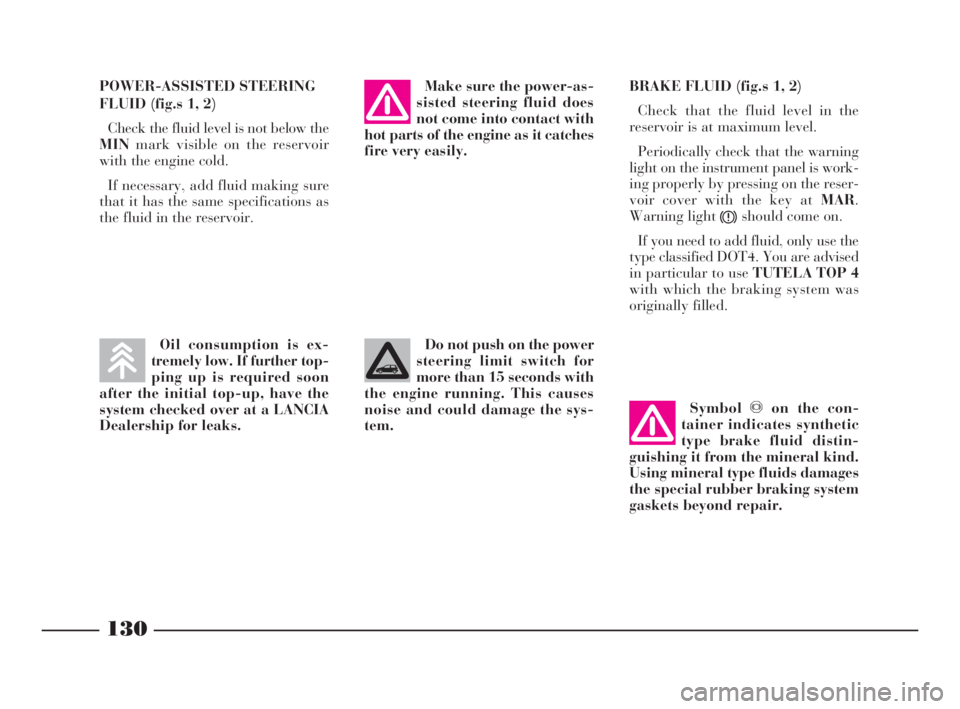
130
G
POWER-ASSISTED STEERING
FLUID (fig.s 1, 2)
Check the fluid level is not below the
MINmark visible on the reservoir
with the engine cold.
If necessary, add fluid making sure
that it has the same specifications as
the fluid in the reservoir.BRAKE FLUID (fig.s 1, 2)
Check that the fluid level in the
reservoir is at maximum level.
Periodically check that the warning
light on the instrument panel is work-
ing properly by pressing on the reser-
voir cover with the key at MAR.
Warning light
xshould come on.
If you need to add fluid, only use the
type classified DOT4. You are advised
in particular to use TUTELA TOP 4
with which the braking system was
originally filled.
Symbolπon the con-
tainer indicates synthetic
type brake fluid distin-
guishing it from the mineral kind.
Using mineral type fluids damages
the special rubber braking system
gaskets beyond repair.
Make sure the power-as-
sisted steering fluid does
not come into contact with
hot parts of the engine as it catches
fire very easily.
Do not push on the power
steering limit switch for
more than 15 seconds with
the engine running. This causes
noise and could damage the sys-
tem.Oil consumption is ex-
tremely low. If further top-
ping up is required soon
after the initial top-up, have the
system checked over at a LANCIA
Dealership for leaks.
4C120-143 ING 11-03-2008 12:01 Pagina 130